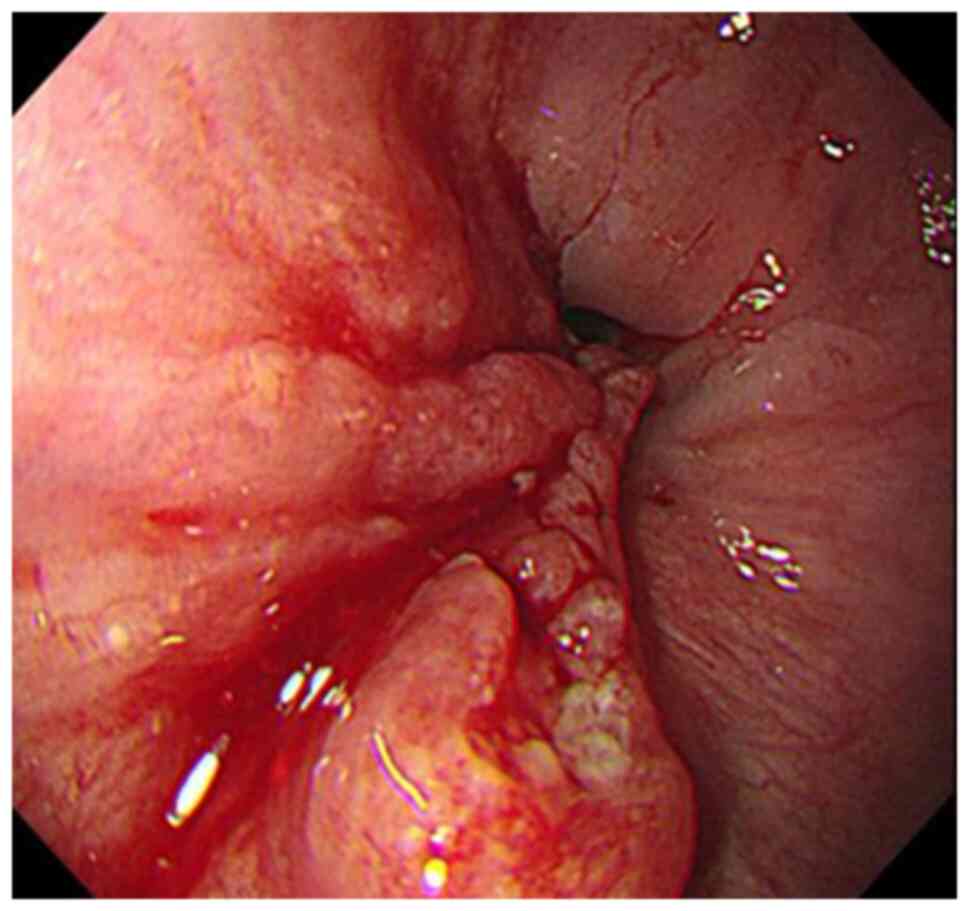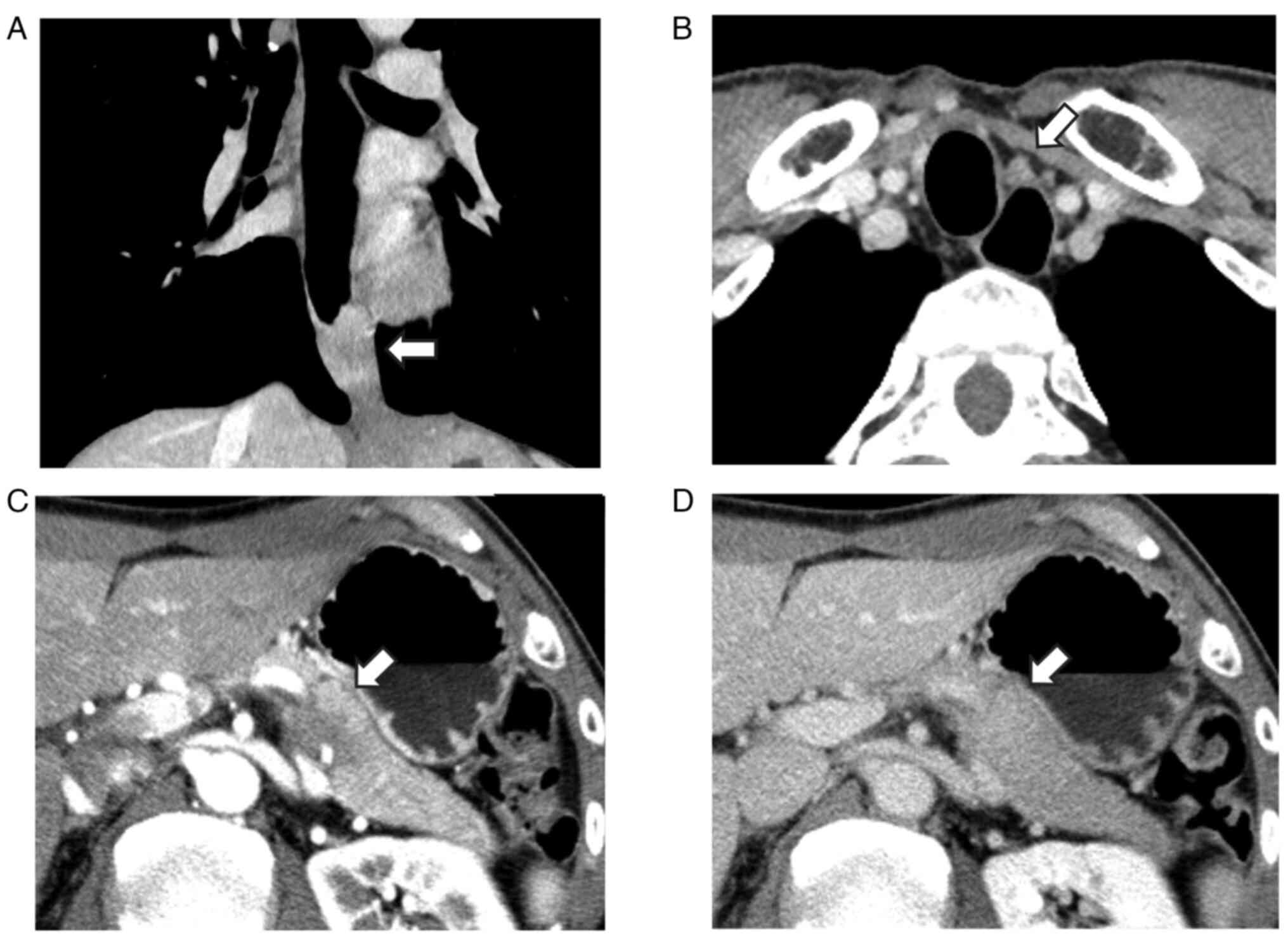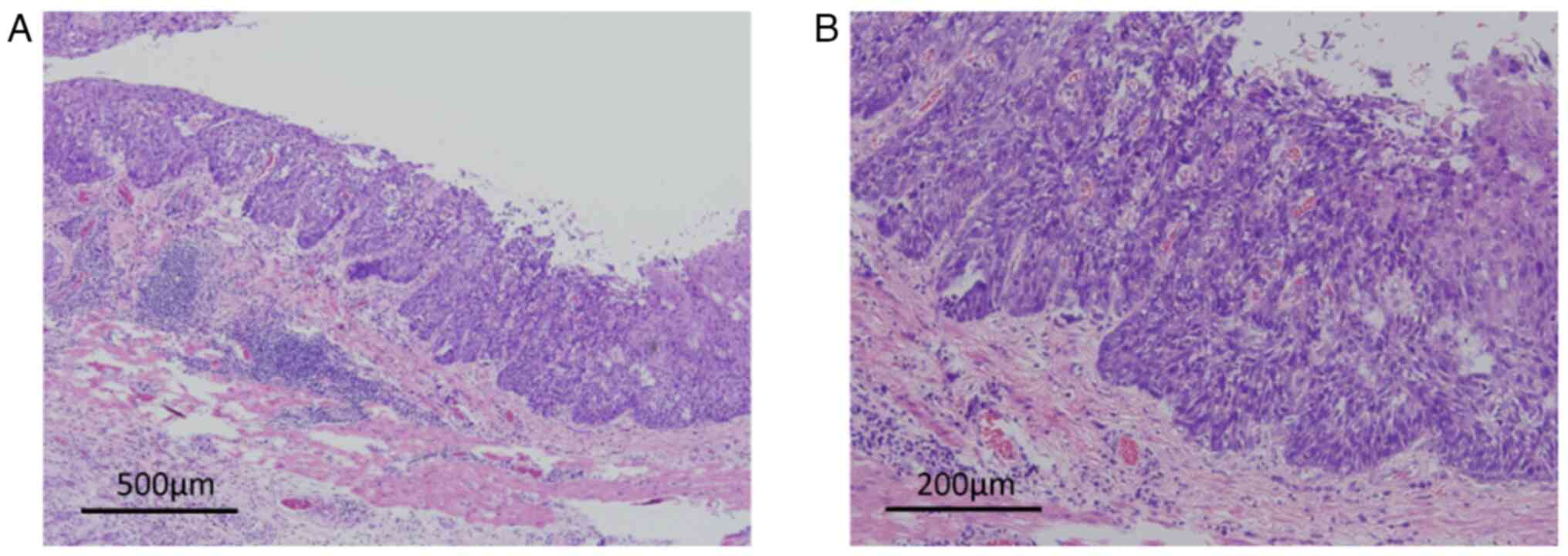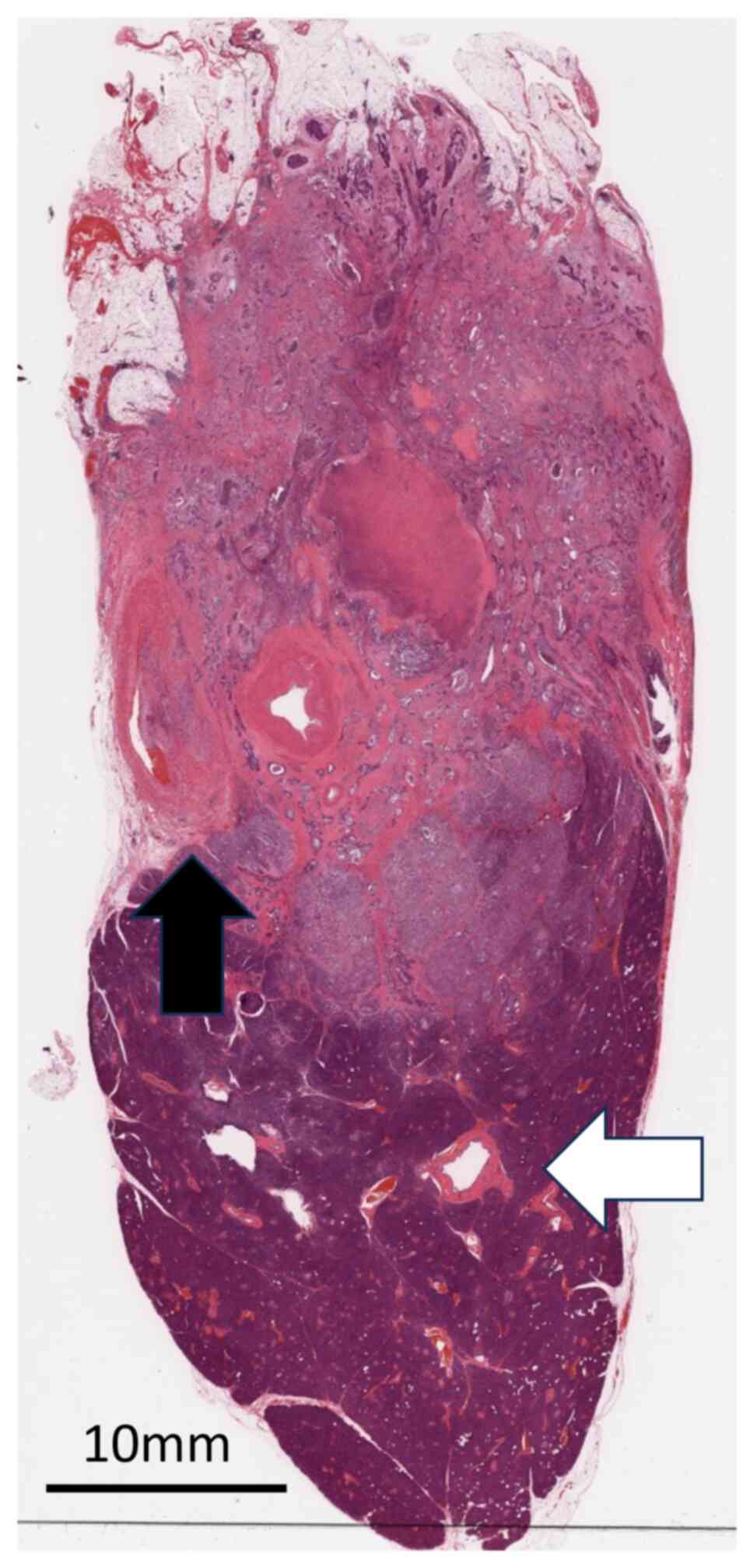Introduction
The therapeutic outcomes of patients with esophageal
cancer have improved in recent years due to the administration of
multidisciplinary treatments, including surgery, chemotherapy and
radiation therapy. However, the recurrence rate remains high and
the prognosis poor. Even following radical esophagectomy, 30 to 50%
of all patients develop hematogenous or lymphatic metastases
(1-3).
However, metastasis from esophageal cancer to the
pancreas is very rare, occurring in <1% of patients with
esophageal cancer, and documented autopsies of patients with
esophageal cancer having reported metastases to the pancreas in 0
to 11% of cases (4). Furthermore,
<4.9% of metastatic tumors in the pancreas originate from
primary esophageal cancers (5-8).
Overall, metastatic disease in the pancreas is rare,
accounting for <2% of all pancreatic malignancies (9). The present study describes the case
of a patient who underwent a simultaneous radical resection of an
esophageal squamous cell carcinoma and a solitary metastasis to the
pancreas, and a review of the literature is also presented.
Solitary pancreatic metastases are rare and are usually resected
when discovered. Moreover, to the best of our knowledge, there are
only a few reports (10-13)
available to date on patients who have undergone resection of a
solitary metastasis.
Case report
A 54-year-old male patient was admitted to the
Nagoya City University Hospital (Nagoya, Japan). The main issue
that the patient reported was chest discomfort after eating, which
had been occurring for several months. The patient was a smoker for
>30 years and consumed alcohol daily.
An esophagogastroduodenoscopy revealed a tumor that
involved almost the entire circumference of the esophagus at a site
36 to 39 cm from the incisors (Fig.
1). An examination of a biopsy using an
esophagogastroduodenoscopy revealed squamous cell carcinoma. Two
pathologists were involved in this evaluation. Computed tomography
revealed no obvious invasion of the surrounding esophageal cancer,
and the 101R lymph node was enlarged (clinical T2N1M0, stage II;
according to the eighth edition of the Union for International
Cancer Control system) (14). A
22x20 mm-sized mass was also detected in the pancreatic tail.
Contrast enhancement of the tumor was poor during the early phase
and exhibited progressive enhancement (Fig. 2). The detected levels of tumor
markers were as follows: i) carcinoembryonic antigen, 3.3 ng/ml
(reference range, <4.1 ng/ml); ii) CA19-9, 2 U/ml (reference
range, <37 U/ml); iii) squamous cell carcinoma antigen, 1.9
ng/ml (reference range, <2.5 ng/ml); iv) DUPAN-2, 25 U/ml
(reference range, <150 U/ml), and v) Span-1, 6.8 U/ml (reference
range, <30 U/ml). Due to esophageal stricture, an endoscopic
ultrasound-guided fine needle aspiration biopsy (EUS-FNA) could not
be performed, and the neoadjuvant therapy was not administered,
since primary pancreatic cancer could not be excluded.
Subsequently, it was decided that the patient should undergo a
resection of both the primary cancer in the esophagus and the
metastatic tumor in the pancreatic tail.
Simultaneous robot-assisted resections were
performed. The histological examination revealed the occurrence of
a squamous cell carcinoma in both the specimens resected from the
esophagus and pancreatic tail by H&E and p40 staining (Fig. 3). The esophageal tumor had invaded
the intrinsic muscular layer, and no in situ carcinoma was
detected (Fig. 4). The pancreatic
mass was located near the superior margin of the pancreas; however,
it was not in contact with either the main pancreatic duct or other
organs. There was extensive infiltration around the splenic artery
and vein (Fig. 5). These were
performed using H&E staining, with a protocol of 4 min of GM
hematoxylin (Muto Pure Chemicals Co., Ltd.) and 2 min of pure eosin
(Muto Pure Chemicals Co., Ltd.) at room temperature. All resection
margins were negative. Several of the lymph nodes near the pancreas
demonstrated metastatic involvement. These analyses were performed
by the Department of Experimental Pathology and Tumor Biology,
Nagoya City University Graduate School of Medical Sciences. The
surgical findings were diagnosed as esophageal cancer with
pancreatic metastasis. The patient recovered without post-operative
complications and was discharged on post-operative at day 34. The
patients received two cycles of 5-fluorouracil (800
mg/m²)/cisplatin (80 mg/m²) chemotherapy following surgery. The
patient remains recurrence-free at 9 months after surgery.
Discussion
Primary pancreatic cancer or pancreatic metastasis
are the most frequently diagnosed entities when squamous cell
carcinoma is detected in pancreatic tumors. Adenocarcinoma accounts
for 75 to 81% of primary pancreatic cancers, and pure squamous cell
carcinoma is very rare (15-18).
According to a 1992 report from Japan, squamous cell carcinoma
accounted for only 0.7% of 1,300 cases of pancreatic cancer
(19). Under normal circumstances,
squamous epithelium is not located in the pancreas. However,
inflammation from conditions including pancreatitis may lead to
squamous epithelialization of ductal columnar cells.
Thus, squamous cell carcinoma of the pancreas is
considered to arise from the squamous metaplasia of ductal columnar
cells secondary to chronic inflammation (20). However, metastases to the pancreas
accounts for <2% of all pancreatic malignancies (9). Metastases from kidney, lung, breast,
colon and skin (melanoma) cancers, along with sarcomas, frequently
involve the pancreas (7). However,
even metastases from squamous cell carcinoma of the lung, which is
the most frequently diagnosed primary cancer with the ability to
metastasize to the pancreas, account for only 1.1% of cases
(21). Consequently, simultaneous
primary and metastatic squamous cell carcinoma of the pancreas is
rare. Of note, a limited occurrence of metastases from a primary
cancer of the esophagus to the pancreas have been reported, to the
best of our knowledge; therefore, the advantages and disadvantages
of resection remain unknown.
Resection for pancreatic metastases from renal cell
or ovarian cancers and complete resection of metastases from any
primary cancer have been reported to be beneficial through the
prolongation of patient survival (8,9,22).
Solitary pancreatic metastases are usually resected; however, a
literature search by the authors revealed 4 patients who underwent
resection of pancreatic metastases from esophageal squamous cell
carcinoma (10-13).
Furthermore, resection of simultaneous metastases was reported for
only 1 of the 4 cases (13).
A review of the surgical data of 5 reported cases (4
from the literature search plus the case reported in the present
study), demonstrated that every patient underwent distal
pancreatectomy and was discharged without post-operative
complications (Table I; 10-13).
Post-operative adjuvant 5-fluorouracil/cisplatin chemotherapy was
administered to 3 patients and there was a report of no recurrence
for up to 24 months (10). The
lower thoracic esophagus was the site of the primary tumor in 3
cases. One case report did not provide the location of the primary
tumor. All pancreatic metastases occurred in the pancreatic
tail.
 | Table IReported cases of pancreatic
metastasis from esophageal carcinoma. |
Table I
Reported cases of pancreatic
metastasis from esophageal carcinoma.
| Author(s) | Year of
publication | Age, years | Sex | Location of
esophageal cancer |
Synchronous/metachronous | TNM stage | Location of
pancreatic metastasis | Surgery | Adjuvant therapy | Recurrence (follow-up
time months) | (Refs.) |
|---|
| Esfehani et
al | 2011 | 59 | F | Lt | Metachronous | T3N1M0 | Pt | DP | 5-FU | None (6) | (12) |
| Park et
al | 2013 | 59 | F | Lt | Synchronous | T1bN1M1 | Pt | DP | FP | None (4) | (13) |
| Okamoto et
al | 2014 | 68 | M | Lt | Metachronous | T1bN0M0 | Pt | DP | FP | None (9) | (11) |
| Koizumi et
al | 2019 | 81 | F | - | Metachronous | T1bN0M0 | Pt | DP | None | None (24) | (10) |
| Present study | 2023 | 54 | M | Lt | Synchronous | T3N3M1 | Pt | DP | FP | None (9) | - |
Blood drains from the cervical esophagus into the
superior vena cava via the inferior thoracic vein, and blood drains
from the upper or middle thoracic esophagus into the superior and
inferior vena cava via the azygous and hemi azygous veins. By
contrast, blood draining from the lower thoracic esophagus and the
abdominal esophagus flows into the portal system via the
paraesophageal vein and the left and short gastric veins (23). Thus, esophageal carcinoma in the
lower thoracic esophagus may be more prone to metastasize to the
pancreas in comparison with esophageal squamous cell carcinomas
located elsewhere, since drainage via the paraesophageal vein to
the splenic vein is the predominant route of blood flow. The
frequency of pancreatic metastases to the pancreatic tail could be
also attributed to the anatomy of the draining veins.
Squamous cell carcinomas discovered in the pancreas
must be determined to be either a primary cancer or metastatic
disease. The frequency of pancreatic metastases from squamous cell
carcinoma is much higher than the frequency of primary squamous
cell carcinoma of the pancreas; thus, it is generally reasonable to
assume that a pancreatic tumor is a metastasis from squamous cell
carcinoma of the esophagus (24).
To the best of our knowledge, there is no immunostaining method
that can further classify the primary squamous cell carcinoma.
Instead, the histopathologic findings in the patient analyzed in
the present study revealed neoplastic changes in the esophageal
mucosa, as well as carcinoma in situ. These findings
indicated that the primary tumor was located in the esophagus.
Additionally, the esophageal and pancreatic tumors exhibited
extensive venous invasion and similar histopathologic profiles.
Furthermore, squamous cell carcinoma of the pancreas is classified
as adenosquamous carcinoma and contains a small amount of
adenocarcinoma component. In the case reported in the present
study, the carcinoma was composed of pure squamous cell carcinoma
lacking an adenocarcinoma component, without being in contact with
the main pancreatic duct and without exhibiting atypical findings
in the main pancreatic duct. It is hypothesized that these findings
serve as indicators excluding the possibility that the tumor is a
primary pancreatic cancer. Considering these data, the tumor in the
pancreas was finally diagnosed as a pancreatic metastasis from
esophageal cancer. The pre-operative confirmation that the tumor in
the pancreas is a solitary metastasis, which leads to the
possibility of a complete resection, is crucial, as the resection
of a solitary metastasis is associated with an improved survival
rate (8,9). In general, the differentiation
between a pancreatic metastasis of esophageal cancer and a primary
pancreatic cancer can be made by a pre-operative EUS-FNA biopsy for
tissue diagnosis (25,26). A pancreatic tumor should be
considered as metastasis, when a tumor is detected in the pancreas
concomitant with an esophageal squamous cell carcinoma being
located in the lower esophagus. The confirmation of the diagnosis
is important for deciding on the treatment, and should be obtained
from a preoperative diagnosis of specimens from EUS-FNA or from
positron emission tomography-computed tomography.
Thus far however, to the best of our knowledge,
there have not been any published prospective or case-controlled
clinical trials that compared the efficacy of resection with the
non-operative treatment of pancreatic metastases. The surgical
mortality of pancreatic surgery has been demonstrated to account
for <5% of the total number of cases diagnosed (9). In addition, since the 5 patients in
the published literature reviewed in the present study remained
alive, surgery for patients with a solitary pancreatic metastasis
from esophageal squamous cell carcinoma may improve outcomes and
should be considered. However, the follow-up periods of the
previous reports were brief, and further observation of these
patients is necessary for the determination of the prognosis of
this type of cases.
In conclusion, the case described in the present
study was reported due to rarity of the solitary pancreatic
metastasis from esophageal cancer and also requires careful
therapeutic consideration. Finally, the treatment guidelines for
esophageal cancer with a solitary pancreatic metastasis should be
established.
Acknowledgements
Not applicable.
Funding
Funding: No funding was received.
Availability of data and materials
The datasets used and/or analyzed during the current
study are available from the corresponding author on reasonable
request.
Authors' contributions
YD participated in all aspects of the present case
report, including management of the patient, conceptualization of
the report, and writing of the draft. MY, IN and KH performed the
pre-operative diagnosis of the patient with a biopsy using an
esophagogastroduodenoscopy and provided advice on treatment
administration. YH, HI, KS and MM managed the patient. HK performed
the histological examination. KN and HM collected the patient's
data. TK, RO and HT aided in interpreting the results and prepared
the manuscript. YM and ST managed the patient and supervised the
study. YM and ST confirm the authenticity of all the raw data. All
authors have read and approved the final manuscript.
Ethics approval and consent to
participate
Written informed consent was obtained from the
patient depicted in the present study.
Patient consent for publication
Written informed consent was obtained from the
patient for the publication of this case report and any
accompanying images.
Competing interests
The authors declare that they have no competing
interests.
References
|
1
|
Nakagawa S, Kanda T, Kosugi S, Ohashi M,
Suzuki T and Hatakeyama K: Recurrence pattern of squamous cell
carcinoma of the thoracic esophagus after extended radical
esophagectomy with three-field lymphadenectomy. J Am Coll Surg.
198:205–211. 2004.PubMed/NCBI View Article : Google Scholar
|
|
2
|
Takeuchi M, Takeuchi H, Kawakubo H, Booka
E, Mayanagi S, Fukuda K, Nakamura R, Suda K, Wada N and Kitagawa Y:
Perioperative risk calculator predicts long-term oncologic outcome
for patients with esophageal carcinoma. Ann Surg Oncol. 25:837–843.
2018.PubMed/NCBI View Article : Google Scholar
|
|
3
|
Shiozaki H, Sudo K, Xiao L, Wadhwa R,
Elimova E, Hofstetter WL, Skinner HD, Lee JH, Weston B, Bhutani MS,
et al: Distribution and timing of distant metastasis after local
therapy in a large cohort of patients with esophageal and
esophagogastric junction cancer. Oncology. 86:336–339.
2014.PubMed/NCBI View Article : Google Scholar
|
|
4
|
Quint LE, Hepburn LM, Francis IR, Whyte RI
and Orringer MB: Incidence and distribution of distant metastases
from newly diagnosed esophageal carcinoma. Cancer. 76:1120–1125.
1995.PubMed/NCBI View Article : Google Scholar
|
|
5
|
Sperti C, Pasquali C, Liessi G, Pinciroli
L, Decet G and Pedrazzoli S: Pancreatic resection for metastatic
tumors to the pancreas. J Surg Oncol. 83:161–166. 2003.PubMed/NCBI View Article : Google Scholar
|
|
6
|
Adsay NV, Andea A, Basturk O, Kilinc N,
Nassar H and Cheng JD: Secondary tumors of the pancreas: an
analysis of a surgical and autopsy database and review of the
literature. Virchows Arch. 444:527–535. 2004.PubMed/NCBI View Article : Google Scholar
|
|
7
|
Masetti M, Zanini N, Martuzzi F, Fabbri C,
Mastrangelo L, Landolfo G, Fornelli A, Burzi M, Vezzelli E and
Jovine E: Analysis of prognostic factors in metastatic tumors of
the pancreas: A single-center experience and review of the
literature. Pancreas. 39:135–143. 2010.PubMed/NCBI View Article : Google Scholar
|
|
8
|
Varker KA, Muscarella P, Wall K, Ellison C
and Bloomston M: Pancreatectomy for non-pancreatic malignancies
results in improved survival after R0 resection. World J Surg
Oncol. 5(145)2007.PubMed/NCBI View Article : Google Scholar
|
|
9
|
Reddy S and Wolfgang CL: The role of
surgery in the management of isolated metastases to the pancreas.
Lancet Oncol. 10:287–293. 2009.PubMed/NCBI View Article : Google Scholar
|
|
10
|
Koizumi W, Kitago M, Shinoda M, Yagi H,
Abe Y, Oshima G, Hori S, Inomata K, Kawakubo H, Kawaida M and
Kitagawa Y: Successful resection of pancreatic metastasis from
oesophageal squamous cell carcinoma: a case report and review of
the literature. BMC Cancer. 19(320)2019.PubMed/NCBI View Article : Google Scholar
|
|
11
|
Okamoto H, Hara Y, Chin M, Hagiwara M,
Onodera Y, Horii S, Shirahata Y, Kamei T, Hashizume E and Ohuchi N:
An extremely rare case of pancreatic metastasis of esophageal
squamous cell carcinoma. World J Gastroenterol. 20:593–597.
2014.PubMed/NCBI View Article : Google Scholar
|
|
12
|
Esfehani MH, Mahmoodzadeh H, Alibakhshi A
and Safavi F: Esophageal squamous cell carcinoma with pancreatic
metastasis: A case report. Acta Med Iran. 49:760–762.
2011.PubMed/NCBI
|
|
13
|
Park C, Jang JY, Kim YH, Hwang EJ, Na KY,
Kim KY, Park JH and Chang YW: A case of esophageal squamous cell
carcinoma with pancreatic metastasis. Clin Endosc. 46:197–200.
2013.PubMed/NCBI View Article : Google Scholar
|
|
14
|
Brierley JD (eds): TNM Classfication of
Malignant Tumours, 8th Edition. Willey-Blackwell,
Hoboken, 2016.
|
|
15
|
Brown HA, Dotto J, Robert M and Salem RR:
Squamous cell carcinoma of the pancreas. J Clin Gastroenterol.
39:915–919. 2005.PubMed/NCBI View Article : Google Scholar
|
|
16
|
Itani KM, Karni A and Green L: Squamous
cell carcinoma of the pancreas. J Gastrointest Surg. 3:512–515.
1999.PubMed/NCBI View Article : Google Scholar
|
|
17
|
Beyer KL, Marshall JB, Metzler MH, Poulter
JS, Seger RM and Díaz-Arias AA: Squamous cell carcinoma of the
pancreas. Report of an unusual case and review of the literature.
Dig Dis Sci. 37:312–318. 1992.PubMed/NCBI View Article : Google Scholar
|
|
18
|
Sears HF, Kim Y and Strawitz J: Squamous
cell carcinoma of the pancreas. J Surg Oncol. 14:261–265.
1980.PubMed/NCBI View Article : Google Scholar
|
|
19
|
Nakashima H, Hayakawa T, Hoshino M, Kamiya
Y, Ohara H, Yamada T, Mizuno K, Inagaki T, Nakazawa T, Yamada H, et
al: Squamous cell carcinoma of the pancreas with massive invasion
of the retroperitoneum. Intern Med. 34:61–64. 1995.PubMed/NCBI View Article : Google Scholar
|
|
20
|
Brayko CM and Doll DC: Squamous cell
carcinoma of the pancreas associated with hypercalcemia.
Gastroenterology. 83:1297–1299. 1982.PubMed/NCBI
|
|
21
|
Maeno T, Satoh H, Ishikawa H, Yamashita
YT, Naito T, Fujiwara M, Kamma H, Ohtsuka M and Hasegawa S:
Patterns of pancreatic metastasis from lung cancer. Anticancer Res.
18:2881–2884. 1998.PubMed/NCBI
|
|
22
|
Yildirim Y and Sanci M: The feasibility
and morbidity of distal pancreatectomy in extensive cytoreductive
surgery for advanced epithelial ovarian cancer. Arch Gynecol
Obstet. 272:31–34. 2005.PubMed/NCBI View Article : Google Scholar
|
|
23
|
Nagashima K, Irisawa A, Tominaga K,
Kashima K, Kunogi Y, Minaguchi T, Izawa N, Yamamiya A, Yamabe A,
Hoshi K, et al: The role of endoscopic ultrasound for esophageal
varices. Diagnostics (Basel). 10(1007)2020.PubMed/NCBI View Article : Google Scholar
|
|
24
|
Al-Shehri A, Silverman S and King KM:
Squamous cell carcinoma of the pancreas. Curr Oncol. 15:293–297.
2008.PubMed/NCBI View Article : Google Scholar
|
|
25
|
Ishikawa T, Hirooka Y, Teman CJ, Goto H
and Belletrutti PJ: An unusual case of pancreatic metastasis from
squamous cell carcinoma of the lung diagnosed by EUS-guided fine
needle biopsy. Case Rep Gastrointest Med.
2017(3212056)2017.PubMed/NCBI View Article : Google Scholar
|
|
26
|
Pannala R, Hallberg-Wallace KM, Smith AL,
Nassar A, Zhang J, Zarka M, Reynolds JP and Chen L: Endoscopic
ultrasound-guided fine needle aspiration cytology of metastatic
renal cell carcinoma to the pancreas: A multi-center experience.
Cytojournal. 13(24)2016.PubMed/NCBI View Article : Google Scholar
|



















